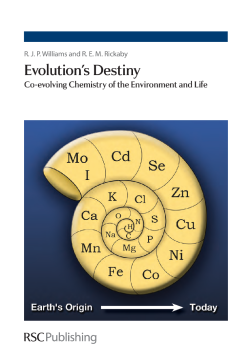
Additional Information
Book Details
Abstract
This book is written as an addition to Darwin's work and that of molecular biologists on evolution so as to include views of it from the point of view of chemistry rather than just from our knowledge of the biology and genes of organisms. By concentrating on a wide range of chemical elements, not just those in traditional organic compounds, we show that there is a close relationship between the geological or environmental chemical changes from the formation of Earth and those of organisms from the time of their origin. These are considerations which Darwin or other scientists could not have explored until very recent times since sufficient analytical data were not available. They lead us to suggest that there is a combined geo- and bio-chemical evolution, that of an ecosystem, which has had a systematic chemical development. In this development the arrival of new very similar species is shown to be by random Darwinian competitive selection processes such that a huge variety of species coexist with only minor differences in chemistry and advantages. This is in agreement with previous studies. On the large scale of evolution of very different organisms, and over greater timescales, by way of contrast, we observe that groups of species have special, different, chemical features and function. It is more difficult to understand how they evolved and therefore we examine their chemical development in detail. Overall there is a cooperative evolution of a chemical system driven by capture of energy, mainly from the sun, and its degradation in which the chemistry of both the environment and organisms are facilitating intermediates. We shall suggest that the overall drive of the whole joint system is to optimise the rate of this energy degradation. Since the environmental changes are inorganic and relatively fast they move inevitably to equilibrium. The living part of the system, the organisms, under the influence of this inevitable environmental change are forced to follow but as they are increasingly energised and their reactions are slow, they move further away from equilibrium. We are able to explore the ways in which this chemical system evolved, recognising that as complexity of the chemistry of organisms increased, they had to be formed from more and more compartments and to become part of a chemically cooperative overall activity. They could not remain as isolated species. Only in the last chapter do we attempt to make a connection between the changing chemistry of organisms with the coded molecules of each cell which have to exist to explain reproduction.
Professor Bob Williams, MA, DPhil, FRS, is Emeritus Fellow at Wadham College and Emeritus Professor, University of Oxford. Born in 1926, he was educated at Wallasey Grammar School. He studied Chemistry at Merton College, Oxford, graduating in 1948. During the course of his Part II work the Irving-Williams series of the stabilities of complex ions, which is of paramount importance in both non-living and living systems, was discovered. He took his doctor's degree at Oxford in 1950 working with Professor H.M.N.H. Irving. With Professor A. Tiselius (Uppsala, Sweden) 1950-51, he developed certain (gradient elution) chromatographic methods of analysis. He then became lecturer and tutor in Chemistry at Wadham College, 1955-65. In 1961 he proposed proton-gradient-driven ATP formation as the driving force of bio-energetics. With C.S.G. Phillips, in 1996, he wrote a textbook of Inorganic Chemistry. After a year at Harvard University, 1965-66, with Professor B.L. Vallee, he changed to teach biochemistry until 1974. With Vallee he noted the entatic (constrained) state of atoms at enzyme sites. He became, successively, a Reader (1972) and Napier Royal Society Research Professor at the University of Oxford (1975-1991). He was elected Fellow of The Royal Society in 1972 and is a Foreign Member of the Swedish, Portugese, Czechoslovakian and Belgian science academies. He has given named lectures series in several European and North American Universities and numerous plenary international lectures at many Chemistry, Biochemistry and Biology Conferences. He is a medallist of the Biochemical Society (twice), The Royal Society (twice), The Royal Society of Chemistry (three times), The European Biochemical Societies (twice) and the International Union of Biochemistry. He has honorary degrees from Louvain, Leicester, Keel, Lisbon and East Anglia Universities. Bob Williams was a founder member of the Oxford Enzyme group in which he and his colleagues devised many new methods for the study of in vitro and in vivo biological systems, especially using nuclear magnetic resonance spectroscopy. He has recently co-edited a book on Chemistry at Oxford: A History from 1600-2005. He has been named as a Citizen of Honour by Oxford City and has an award from Oxford Preservation Trust for the effective creation of Sunnymead Park in North Oxford. He remains particularly proud of the success of his pupils in all walks of life. Professor Ros Rickaby is Professor of Biogeochemistry at the University of Oxford. Her main research themes include the environment, oceans and climate and lectures in the fundamentals of chemistry, stable isotope geochemistry and the evolutions of climate on long and short timescales.
